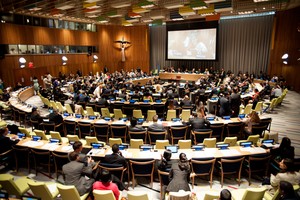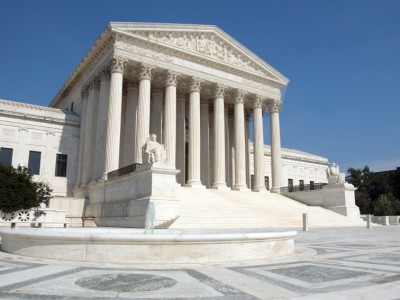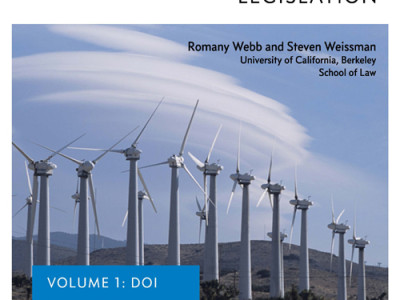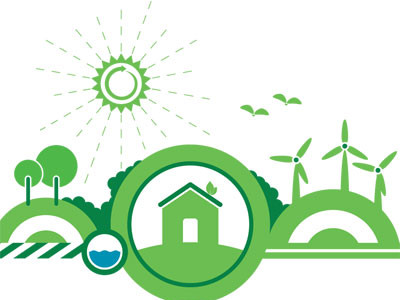The Top 10 Reasons Why EPA’s Powerplant Rule is like Obamacare
Death Panels! War on Coal!
Opponents in Congress have likened EPA's proposed rule covering greenhouse gas emissions to Obamacare. In fact, one called it "Obamacare 2.0". In a helpful spirit, I thought it would be edifying to list the similarities: 1o. The powerplant rule and Obamacare both give state government a major role. 9. They were both endorsed by President Obama. 8. They both reflect intense consultation with stakeholders. 7. Both also reflect a lot of expert input. 6. ...
CONTINUE READINGDo EPA’s Carbon Emissions Rules Point to a New Climate Treaty? Nope.
The Future Global Climate Regime Will Not Rely on an International Accord
The irrepressible Jonathan Chait continues to do what he does best: shredding the GOP's neanderthal nihilism on climate (or as Andrew Sullivan notes, the Republican Party has become "a reckless, know-nothing, post-modern fantasy machine."). But Chait makes one big leap of logic that should actually be scotched. Chait points out that contrary to conservative predictions that other countries would not respond in kind to Obama's initiative, China already has begun to m...
CONTINUE READINGJudicial “Smoke Signals” and the 111(d) Rule
In an earlier post, I suggested that EPA's decision about how broadly to write the final version of the 111(d) rule might be affected by the Supreme Court's decision in the pending UARG case. I made the suggestion without much explanation, and it apparently didn't come across very clearly. So I thought it would be worth offering a brief clarification. The Supreme Court has made it clear in two separate decisions that the Clean Air Act covers greenhouse gases such...
CONTINUE READINGAddressing Climate Change Without Legislation
A new report from UC Berkeley looks at the underused powers of the US Department of the Interior.
Now that the Environmental Protection Agency has announced its proposed rules for restricting greenhouse gas emissions from existing power plants, the climate focus of EPA and the states will first be on polishing the rules for final approval, then on the anticipated law suits, and then on the development of state plans to meet the reduction targets. If only that was all we needed to do. While the proposed rules represent a dramatic shift in the federal government’s ap...
CONTINUE READINGThe Legal Basis for the 111(d) Rule
EPA has structured the rules to protect against legal challenges.
Megan has done a great job of explaining the background of the rules and summarizing the proposal in her blog posts. I just wanted to add a quick note about how EPA has structured its rules in light of possible legal challenges. The fundamental issue facing EPA is how to define the "best system" for reducing carbon emissions. Is it limited to technological upgrades at individual emitters? Or can it be broader, and if so, how broad? Industry is sure to argue th...
CONTINUE READINGEPA Releases Section 111(d) Rule for Existing Power Plants
Rule would reduce climate change-related carbon dioxide emissions from existing power plants 30 percent below 2005 levels by 2030
Today, EPA formally released its long-awaited rule to regulate carbon emissions from existing power plants under Clean Air Act § 111(d). Read the full text of the rule here. As leaked to the media yesterday, the rule would have the overall effect of reducing carbon dioxide emissions from electric generating units (EGUs, or power plants) 30 percent below 2005 levels by 2030, with interim goals starting in 2020. Each state would have its own rate-based carbon di...
CONTINUE READINGEPA’s Proposed Greenhouse Gas Emissions Rules Are Remarkably Business-friendly
Business wins on baseline year, flexible compliance methods will keep costs down
President Obama's EPA will tomorrow issue proposed greenhouse gas limits for existing power plants. By all accounts the rules will be a remarkable step forward in the fight against global warming, with the U.S. finally demonstrating significant leadership on an issue on which it has lagged behind for more than a decade. And yet from what we know about the proposed rules, they are market and business-friendly in a way that press accounts so far have yet to emphasize. ...
CONTINUE READINGEPA to Release Proposed Rule for Existing Power Plants under Clean Air Act 111(d) that Cuts Carbon Emissions 30% from 2005 Levels by 2030
This rule represents one of the most significant actions ever taken by the United States to mitigate climate change
Major news outlets are reporting that the U.S. Environmental Protection Agency (EPA) will release on Monday a proposed rule for the regulation of existing power plants under Clean Air Act section 111(d) that would reduce carbon emissions from the electrical generating sector 30 percent from 2005 levels by 2030. This rule follows the recent release of portions of the IPCC’s Fifth Assessment Report and the U.S. National Climate Assessment, and represents one of the most ...
CONTINUE READINGObama’s Section 111d Plan Has Support From George H.W. Bush’s EPA General Counsel, Utility Executives
E. Donald Elliott calls EPA's approach
When President Obama's Environmental Protection Agency releases its Clean Air Act Section 111(d) regulations to control greenhouse gases emitted by the electricity sector on Monday, we can expect howls of protest from the usual suspects: Congressional Republicans, industry groups representing big coal interests, even some coal-state Democrats. But the Obama approach is already receiving praise from less predictable quarters. E. Donald Elliott, the EPA General Coun...
CONTINUE READINGGuest Blogger Joel Eisen: D.C. Circuit Vacates FERC Smart Grid “Demand Response” Rule
Joel B. Eisen is Professor of Law and Austin Owen Research Fellow at University of Richmond School of Law. His scholarly work is available here. Last Friday (May 23), in Electric Power Supply Association v. FERC, a D.C. Circuit panel split 2-1 and vacated Order 745, a Federal Energy Regulatory Commission (FERC) rule designed to promote “demand response” (DR). DR is a rapidly growing and valuable means of reducing electricity demand, thereby benefiting consumers an...
CONTINUE READING









